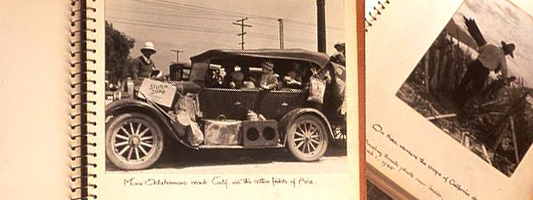[Detail] Sketchbooks with gelatin silver prints and ink notes
Lesson Procedure
Lesson One - Ethnography - Students read and view examples of ethnographic research.
Lesson Two - Photo Analysis - Students view and analyze photographs from the American Memory collections.
Lesson Three - Oral History - Students conduct a mock interview with a character from The Grapes of Wrath.
Lesson Four - Material Artifacts and Textual Support - Students locate artifacts in the American Memory collections that relate to the character interviewed in Lesson Three.
Lesson Five - Museum Exhibition - Students combine their findings from their interviews and artifacts into a museum exhibit.
Extension - Collect additional artifacts.
Lesson One: Ethnography
- In order to have students better understand ethnography, have them read background on Alan Lomax's ethnographic process: What is an Ethnographic Field Collection?.
- Show sample pages from The Forgotten People.
Lesson Two: Photo Analysis
- Have students analyze selected Farm Service Administration photos from American Memory, recording their thoughts on the Primary Source Analysis Tool. Before the students begin, select questions from the teacher’s guide Analyzing Photographs and Prints to focus and prompt analysis and discussion.
- Allow students to view additional photographs from the American Memory collection, America from the Great Depression to World War II: Photographs from the FSA and OWI, ca. 1935-1945. Students select three additional photographs from the collection, completing a Primary Source Analysis Tool for each photograph.
Lesson Three: Oral History
- Have each student select a character from The Grapes of Wrath to use as a focus for an interview.
- Read the model questions from the Fieldwork Data Collection Survey (PDF, 46 KB). Students should use this form when conducting their interviews with their chosen characters from the novel.
- Students need to imagine how their chosen characters would respond to each of the interview questions. Some of the answers will come from the book and others will be hypothetical based on the character's motivation.
- Remind students that authors generate characters through:
- physical description;
- thoughts;
- actions;
- dialogue;
- reactions to other characters; and
- other characters' reactions.
- Have students write a brief transcript of the interview. The transcript should include references to physical objects and other elements of local color which can be seen as symbols for larger ideas in The Grapes of Wrath.
Lesson Four: Material Artifacts and Textual Support
- Students search the American Memory collections for artifact illustrations from the following categories relating to their character from The Grapes of Wrath. Include ten artifacts from at least five categories. Begin the search at: America from the Great Depression to World War II: Photographs from the FSA-OWI, 1935-1945.
- Have students write a museum-like caption for each artifact. Each caption should explain the fictional context and literary significance of the artifact.
- Finally, have students choose passages of text from The Grapes of Wrath to accompany each of the artifacts. Each of the text passages should be cited using the preferred format.
Lesson Five: Museum Exhibition
As a culminating activity, students create a museum exhibition that shows a meaningful juxtaposition of artifacts, interview, and text that supports a theme. The exhibit should focus on a particular theme or issue uncovered in the character interview.
Possible formats for the exhibit include collage, PowerPoint, iMovie, multi-genre essay, journal, photo-essay, or scrapbook.
Museum exhibitions should include the following elements which show how material artifacts act as literary symbols that support a specific theme from The Grapes of Wrath:
- Exhibit narrative of at least ten sentences summarizing the exhibit's contents and theme.
- Ten artifacts from the American Memory collections that exemplify items described in the The Grapes of Wrath.
- Museum-like caption for each artifact.
- Text reference for each artifact.
- Bibliographic entry for each artifact. (For information about citing online sources see Citing Electronic Sources.)
- Fieldwork Data Collection Survey from interview with character. (PDF, 46 KB)
Extension
Students can collect additional artifacts from the following areas listed below. Included are many cultural elements, such as those listed below, which can function as literary symbols.
Oral Tradition and Performance
- Spoken Word: tall tales, legends, humorous stories, beliefs, superstitions, personal experience stories, proverbs, riddles, toasts and testimonies, mnemonic devices (rhymes), nursery and game rhymes speech play, ritual insults, jokes, family histories, vocabulary and grammar, dialect and idiomatic speech, sermons
- Song: ballads, children's songs, work songs, blues (urban and country), sea shanties, ethnic songs, play-party and games, songs
- Dance: clogging, square dance, round dance, buck dance
- Game, Play, and Strategy: tag games, guessing games, seeking games, competitive games (dueling, daring, racing), game strategy (rules and techniques), acting, pretending
- Artifacts: houses, outbuildings, barns, floor plans, roofing materials, masonry, wall and fence constructions, tools and implements
- The Cultural Landscape: wall and fence placement, farm planning, farming techniques, rural and urban use of land and space, physical and economic boundaries of regions and neighborhoods
- Foodways: food preparation, recipes, gardening, canning and curing processes, traditional meal preparation, religious or symbolic uses for food
- Crafts and Trades: boat building, blacksmithing, coal mining, tool making, papercutting, pottery, sailmaking, ropemaking, weaving, straw work, animal trapping
- Folk Art: graphic arts, furniture decoration, embroidery, beadwork, wood carving, jewelry making, yard and garden decoration
- Folk Medicine: home remedies and cures, midwifery
- Traditions
- Customs
- Religious observations
- Rites of passage (birth, baptism, marriage, death)
- Gesture, body movement, and use of space
- Seasonal and calendrical events
- Saints and nameday celebrations
- Feast days
- Market days
- Transportation
- Communication
- General Maps

